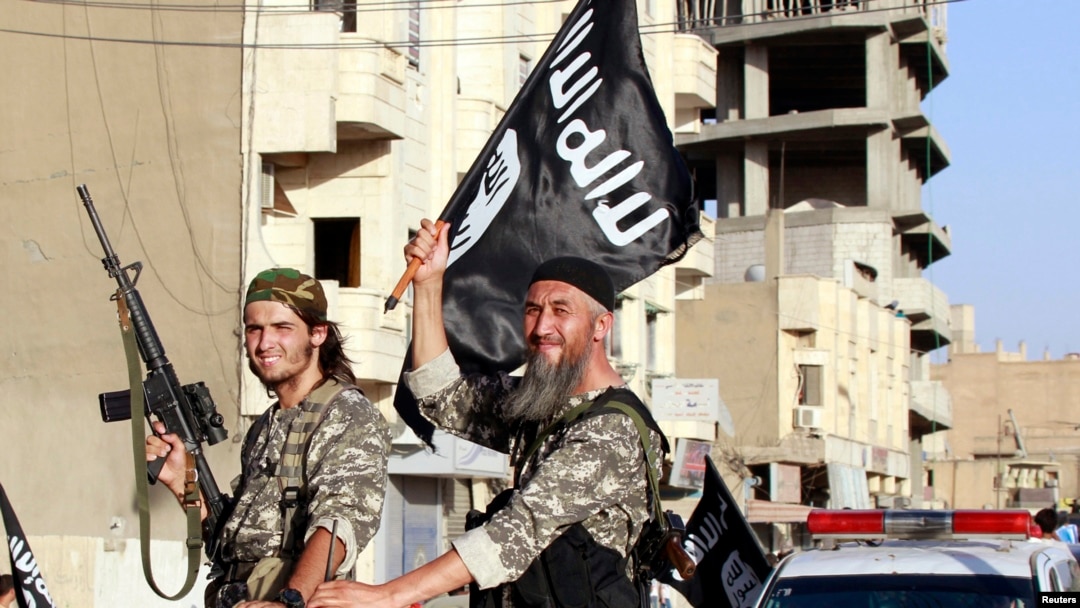Along with its fast moving and brutal militant conquest of land in eastern Syria and northwestern Iraq, the Islamic State extremist group has a phenomenal virtual capacity through social media.
According to Staffan Truve, an analyst with Recorded Future, a group that monitors Twitter and other social media, this summer there were more than 60,000 accounts talking about the Islamic State extremists in a positive way.
Multiply that by an average account’s retweets, and the group’s use of other social media including an Android app, and hundreds of thousands of people are receiving the Islamic State message, Truve says.
The numbers are indicative of the extremists’ carefully tailored global outreach and recruitment efforts. And they are hard to shut down. Every time a pro-IS Twitter account is closed, another one almost immediately takes its place, says Truve.
“I would say their media strategy is very thought out, both in terms of mechanisms ensuring that they don’t get shut down, as well as actually having developed tools to create this broad coverage and ripple effect of their media messaging," Truve told VOA from his base in Sweden.
The Islamic State’s international recruitment drive is equally skillful, says Patrick Skinner with the Soufan Group, a security intelligence services company.
The group's message, he says, is carefully tailored to specific demographic groups in Europe, the United States, South Asia and locally in Iraq and Syria. In the West, they try to make jihad seem like a Hollywood-like video game.
“They make jihad seem cool, not over the top - beheading videos aren’t recruitment videos - but they do do very slick productions, with music overlaid on top of very slick graphics, and they make it seem like a video game. They don’t show the after effects. They'll show an attack or they'll show a killing, or they'll show shooting with explosions, and it’s very Hollywood-like," says Skinner.
Analysts say the Islamic State also makes a point of showing jihadists with kittens, or with products such as Nutella ((a chocolate spread)) or Skittles ((a colorful candy)) in an attempt to humanize their fighters and create a sense of camaraderie with those they are trying to reach.
“They are picking this segment of people that are looking for more excitement or looking for an alternative, counterculture lifestyle, looking for converts or looking for people looking for a slightly edgier life," says Skinner. "So their online outreach is pretty slick, they don’t go over the top, they basically make it seem like a video game or make it look like a cool gang, and it’s anti-establishment, then they start bringing in the ideology.”
Locally, the extremists use radio and radical imams to spread their message and get more entrenched, the former CIA officer says. For example, there is a targeted appeal for “jihadi brides” to marry their fighters and establish their “caliphate.”
As part of the Islamic State’s recent outreach into areas that were normally al-Qaida strongholds, such as the Pakistan-Afghanistan border area that has little or no Internet bandwidth, the group has gone more low-tech, distributing pamphlets in the local languages of Pashto and Dari.
The pamphlets call for younger Muslims to join them in their battle against Western “crusaders” and refer to Afghanistan by its former name of Khorasan, an ancient region that encompassed large areas of Iran, southern Turkmenistan and northern Afghanistan.
Phillip Smyth, a researcher at the University of Maryland who specializes in Islamist militarism in the Middle East, says using social media allows extremists and their sympathizers to directly and indirectly target possible followers.
"It’s a whole other sub-universe," he says. "And it can actually encourage, they give you the means to actually contact these organizations, to contact people you believe are fighters, or those who are recruiters, and they can route you to the right destination.”
Smyth notes the U.S. State Department is actively trying to counter the Islamic State recruitment with their own social media accounts. But he says it is difficult to determine the effectiveness this U.S. strategy.
According to the International Centre for the Study of Radicalisation and Political Violence, most of the extremists' information reaches these potential fighters through jihadist sympathizers, not necessarily the Islamic State or the al Qaida-linked Jabhat al-Nusrah official channels. This makes it harder to halt the propaganda.
The group identified two of the most popular jihadist motivators as Ahmad Musa Jibril, a US-based preacher who justifies the Syrian conflict, and Musa Cerantonio, a younger Australian convert.
Skinner says the Islamic State’s sophisticated media campaign and brutal on-the-ground militant actions have firmly established their presence. "ISIS is the poster boy for extremist groups. Anybody who is looking to decide, if you are shopping for jihad, you would go with the best brand and it used to be al-Qaida. Now, for the last six months and for the foreseeable future, it’s ISIS.”
Skinner warns that the Islamic State group is also trying to goad the United States and the West into attacking, in their hope of uniting all extremist groups under their banner.


